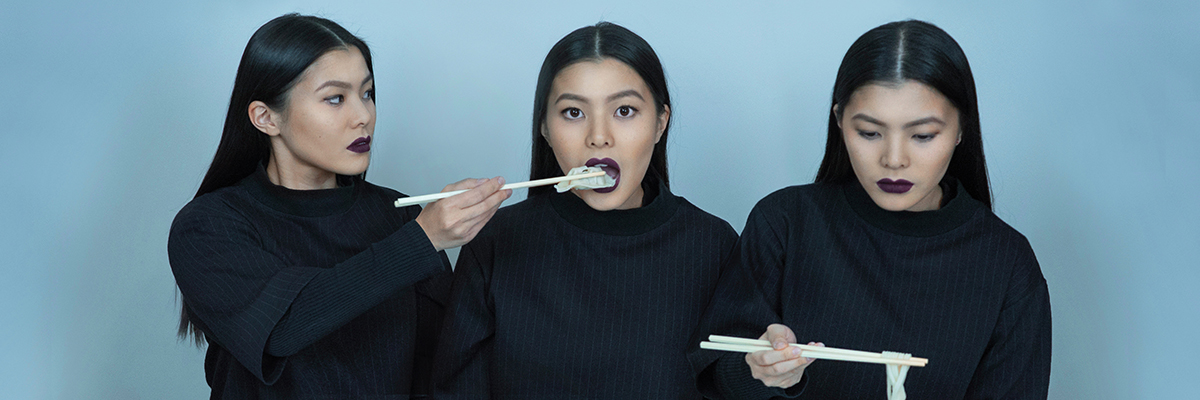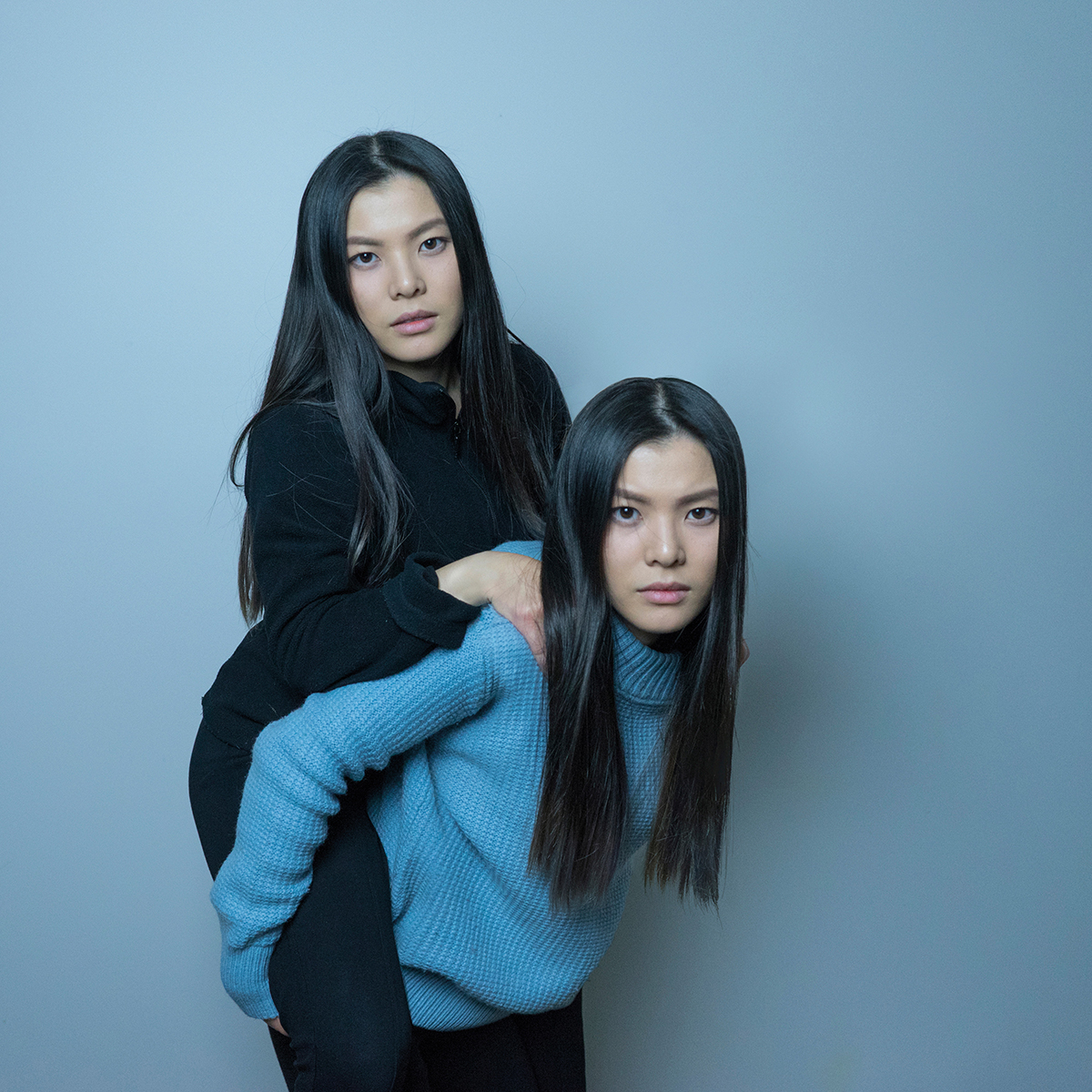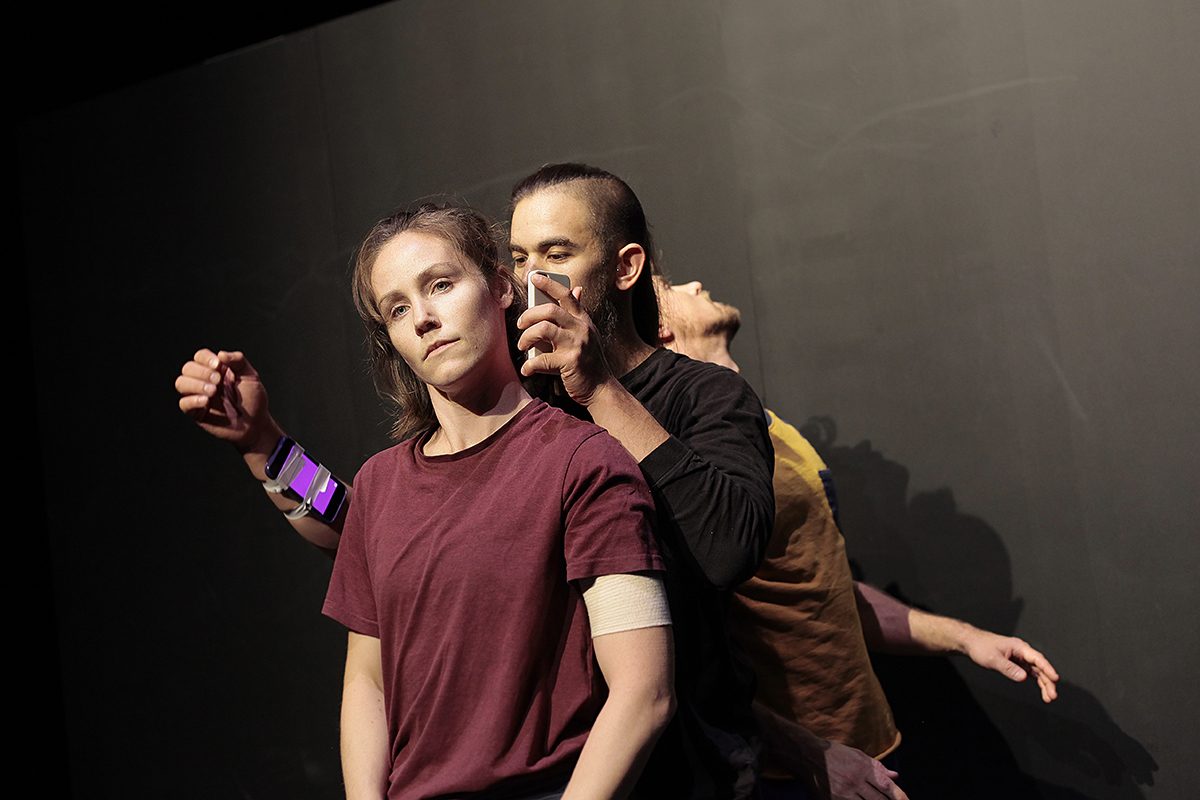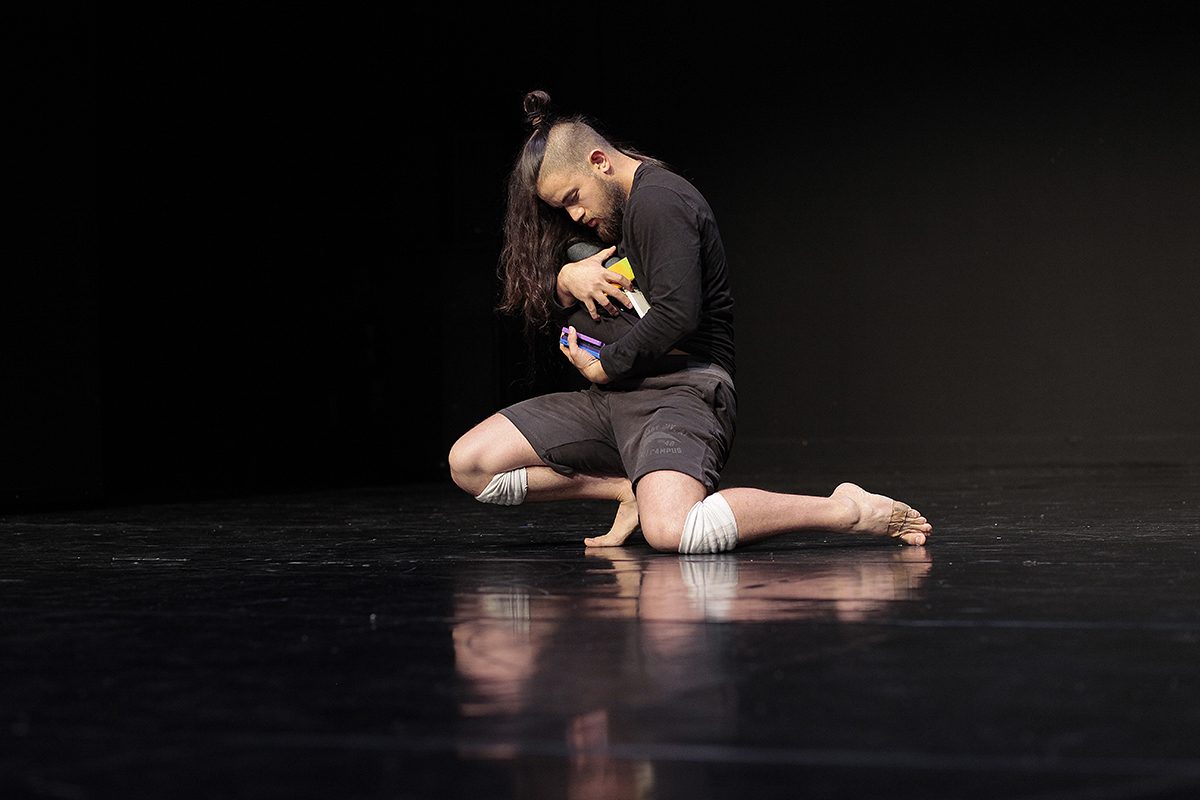We first spotted the work of Gwan Tung Dorothy Lau in the catalogue for this year’s HATCHED National Graduate Show at Perth Institute of Contemporary Arts. Her work titled Para-Selves consists of a series of striking double and triple images of the artist herself in various guises. The intriguing aspect of these digitally manipulated portraits is the subtle changes in expression and gesture, which make the subject appear as if she is adjusting her own image or presenting a number of versions of herself — one aggressive, another passive, or as Lau describes them, “physical interactions with my doppelgangers” — within the same frame. Lau says, “Para-Selves interrogates how these conflicting representations can paradoxically co-exist.” As well as building on this photographic self-portraiture series, she has also created installations and wearable art.
Dorothy Lau received her Bachelor of Fine Arts (Visual Arts) with distinction at Queensland University of Technology in 2016. She is currently undertaking a Master of Fine Art degree with RMIT and Hong Kong Art School. An active member of Brisbane’s local art scene before her recent relocation to Hong Kong, she was involved in an artist residency at House Conspiracy event space in Brisbane and contributed to curatorial programs with several Brisbane artist-run initiatives. She has exhibited internationally at PMQ (Hong Kong) and London Gallery West (UK) in addition to Melbourne, Sydney and Perth galleries.
In an email exchange, I asked the artist about her work and how her education has influenced it.

Para-Selves #3. 2016, Gwan Tung Dorothy Lau, digitally manipulated photograph courtesy the artist
What motivates your art-making?
Using an auto-ethnographic approach, my works initially draw from the feelings of confusion and frustration that derive from assessing my cultural identity. I have dual citizenship; I was born and raised in Hong Kong and spent the last six years in Australia to further my education. I observe the ways my cultural identity influences my experience in Brisbane and Townsville. These are important starting points but I believe that my works should not merely document and interpret my experience, or present a therapeutic process, but rather I employ this self-inquiry to relate to a greater social context. I examine the way my actions oscillate between conforming to and excessively defying generalised portrayals of East-Asian culture. By figuratively depicting that observation, I attempt to evaluate and critique the influences of Western social expectations on cultural minorities. While I provide a personal and intimate account of the notion of displacement, I acknowledge that this is a bigger social issue and experienced by millions of people in similar situations. I am now pursuing postgraduate studies in Hong Kong and relocating temporarily to see how my exploration of cultural identity will develop once it is removed from a Western context.
Who are some of the artists who’ve inspired your work?
Some key influences are Mona Hatoum, Cindy Sherman and [leading Chinese contemporary artist] Cui Xiuwen. Their works respectively inform the conceptual, methodical and formal aspects of my practice. I’ve also studied the work of Australian contemporary artists who deal with the issue of identity such as Michael Cook, Christian Thompson and Thai-Australian artist Nathan Beard. This research helps me locate my works contextually in the contemporary art landscape while also giving me insights into the rationale behind my creative decisions.
How important to your art has your university education and training been?
My undergraduate education at QUT was fundamental to developing my practice and my understanding of contemporary art. Rather than initially training our technical skills in a specific discipline, we got to develop our practice conceptually across a range of mediums and methodologies. In my first year, I experimented with all sorts of processes and materials from using clingwrap and cardboard to chopping up metal pieces using the big machines in the workshop. I think the freedom and encouragement to experiment I was given in the initial stages of the degree was critical, as it allowed me to explore art beyond traditional painting, which, to be frank, was the only medium I was invested in before going into the course.
Being exposed to thematically curated collections of modern and contemporary art during seminars and lectures also broadened my definition and understanding of what art can be. So, initially I was allowed to go crazy and be ambitious with materials and processes. The group critique sessions and individual consultations then demanded I review what was working and what wasn’t, and where my works were situated contextually, and gradually assisted me in developing a clearer understanding of what I was doing. It wasn’t until my final year that I finally started to comprehend what themes I felt most compelled to explore in my art. The guidance and critique from the teachers were crucial. I still try to evaluate my works in a similar way after graduating. My BFA at QUT basically shaped my practice.

Para-Selves #4, 2016, Gwan Tung Dorothy Lau, digitally manipulated photograph courtesy the artist
In your show coming up later this year at Brisbane’s Artisan Gallery, you’re presenting a very different but equally paradoxical work. A sculptural piece that when worn (as in earlier showings) could be interpreted as cumbersome baggage or even some kind of enveloping entity. Then again, it’s soft and covered in pretty pink material. Even the title Gloom is contradictory.
It actually predates Para-Selves. While that series directly confronts the confusion of cultural identity, Gloom embodies a more passive response. It presents the difficult process of introspection as a burden to the body. I created Gloom as a wearable artwork using a mixture of garment-making methodologies, developed from my experience working for a fashion designer, and domestic crafting processes. The material choice of pink embossed fleece and yarn, and the craft aspect of the work connect to childhood, which I associate with safety and certainty. The work presents my desire to retreat from the feeling of displacement and reconnect to the past.
I had previously shown Gloom on a mannequin at my graduate show and on a white chair next to a dining table in a traditional Queenslander house during my residency with House Conspiracy. I was aware how differently the work operates in these situations. Gloom was my first venture in wearable art. I think there are a lot of possible extensions.
–
Gwan Tung Dorothy Lau, Gloom, Ivory Street Window Gallery, Artisan Gallery, Brisbane, 4 Oct-5 Nov
Top image credit: Gloom, 2016, Gwan Tung Dorothy Lau, photo courtesy the artist
Surveillance can save, it can enslave, help capture criminals and simultaneously undermine civil liberties. It’s no longer just pervasive CCTVs that can equally reassure and engender anxiety, but the too-smart phones which have become our physical, financial and emotional prostheses. We self-surveil, often willingly, frequently unknowingly via software and apps that locate and identify us — often wrongly, as Sue Halpern scarily recounts in “They Have, Right Now, Another You.”
And then there’s spying on partners, children and friends.
Film and television thrillers and documentaries constantly alert us to the insidious nature of ever increasing public surveillance and a range of theatre directors have inventively appropriated spying by camera, notably Benedict Andrews in his productions of The Season at Sarsaparilla (2007), with its Reality TV invasiveness, and Measure for Measure (2010), which amplified the work’s sense of dictatorial power. But a dance work about surveillance? A fascinating prospect for a form not inclined to the literal, although the likes of Garry Stewart and Lucy Guerin have on occasion brilliantly made issues, concepts and phenomena substantially palpable in dance.
Intrigued, I spoke by phone with choreographer Lisa Wilson (best known for Lake, 2012, and other works for Sydney Dance Company and the Australian Ballet) and composer Paul Charlier (a seminal Australian theatre sound designer) who were in rehearsals at the Judith Wright Centre where their new work Wireless will shortly premiere, after a long gestation. Wilson tells me the idea for the work came from Charlier in 2012.
From the Stasi to the smart phone
The trigger for the work, says Charlier, came from an experience in Leipzig in 1998, when he went to the recently opened Stasi Museum. “When the Stasi had been destroying their files in the last days of the government, some of the shredded files were mixed with flour and water so that they couldn’t be put back together again as had happened in Iran before that and is still going on in Berlin. It’s ‘klump,’ like papier-mâché.” Charlier was given a piece as a thank-you for coming to the museum.
“And then in 2011, I was going through the app store looking for things to do with musical instruments and I noticed that there was an incredible explosion of apps that seemed to be designed for personal surveillance. Some of them were called straight out, like ‘Love Spy.’ Lots of them were disguised as baby monitors but they had pictures of adult bed-rooms indicating they could be used for other reasons. Things have moved on,” said Charlier, “from Foucault’s use of Bentham’s panopticon as a metaphor or descriptor, since that relies on knowing you’re observed, as in the case of the Stasi. Now it’s more of a ‘cryptopticon’,” to use a term coined by Siva Vaidhyanathan — hidden surveillance, such as invisible data collection from your phone.
“So part of the idea I suggested to Lisa was about using these off-the-shelf apps to create a soundtrack to do a piece about surveillance, to actually use personal surveillance apps to do the piece. So all the original apps that we used were off-the-shelf. That was like a rule. I wasn’t going to make any bespoke software, just use what was available.”
Apps that intrude
But things have changed. This was before Snowden came out. And a lot of the apps were taken down because people were aware what they were doing. Actually, one of the apps we looked at wasn’t from an app store but one I’d come across; it was the same one that [convicted murderer] Simon Gittany had used to put on [his victim] Lisa Harnum’s phone before killing her. Reading the judgement of his court case in 2016 had a huge effect on the piece as well because it was this absolutely small, personal case of open surveillance of another person. An awful example of surveillance as a means of control, not just digging up information. And that resonated with the the Stasi Museum experience.”
The phone as motion sensor
I ask how Charlier and Wilson are using phones in performance. Charlier explains, “We’re using the 25 or more sensors that don’t ask your permission when you use your phone. Your phone asks if you want to use your camera and your microphone and your GPS but in the phone is a whole collection of motion sensors that have an extraordinary range of uses. So attaching motion sensors to dancers just seems to make sense. These motion sensors are incredibly sensitive and usually when people make games on phones, the first thing they have to do is to get rid of most of the data they make because they are so sensitive. We had a phone on the first floor of the rehearsal room here and it was measuring the vibration of the building! There’s a sensor you use to measure the quality of your sleep in apps, that measure your steps when you’re running. But now they’re so sensitive that there are people who are attempting to measure your blood rate from your pocket using these sensors with the purpose of being able to work out your mood.
“And these sensors are incredible dance critics, Keith. At first, to the eye, the movement of a dancer six times in a row might look exactly the same. The sensors are so precise they know there are very very tiny differences between them.”
Asked how she integrated the technology with the dance, Wilson recalls that “in the very early days, we wanted to play with possibilities and then triggered improvisations, scenes instigated from a purely physical place. We’ve tried to use the equipment in different ways. In some scenes, we’re holding them. Sometimes we’re creating sound with them. There are scenes when no phones are involved and there’s a scene where a performer has three phones attached to him — we see how that evolves and he generates a score. So the phones are used in very different ways — vignettes within a larger context.”
I wonder how literally the subject matter is addressed. Wilson says that in looking at privacy “there’s a reasonably literal piece — well, as literal as abstract dance gets—based on the Lisa Harnum case. We call it the Apartment Scene. It’s not like a direct narrative; it’s based more on the dynamic of that relationship.”
Making the phone visible
Charlier comments on the performative use of the phones. “There’s an extraordinary naturalness now in seeing people with phones in their hands. It got to a point in some of the early developments where the phones actually started to become invisible. There’s nothing unusual about someone dancing with a phone. We had to reconfigure the beginning of the show to make the phones almost characters—not quite, we’re not trying to anthropomorphise them.” “They’re a presence,” says Wilson.” “Yes,” adds Charlier, “to make them more of a presence so that when picked up they don’t become ‘dead’ props.” He’s also had the visual interface of the original app found in a store adapted by the maker in California, “so that when a dancer has it attached to them under a Tubigrip compression bandage, you forget it’s a phone. It looks like a glow emanating from a wound. Quite a powerful image.”
I’m curious about Wilson’s mention of the dancers generating sounds as they perform with the score. Charlier explains, “At one extreme there’s a piece of music that’s broken up, the dancer triggering each phrase or part of a phrase. So in a way, the dancer is inserting pauses. The first time we did this it was extraordinary for me, that she danced it back, played it back in a way that I had never actually thought about and inserted pauses that hadn’t occurred to me. It’s a pretty extraordinary thing to give over control of your work to a dancer. The great thing about it is the silence and the pauses. Silence becomes them stopping, becomes part of the music.
At the other extreme we have the dancers generating notes, And that gets into some pretty wild territory because we’re not using it to reproduce electronic music or dance music. It really is its own sound. It is the sound of the dancers moving.”
Wilson says, “I find this choreographically really interesting to get the dancers both instigating but yet responding to the sounds they’re making. So that shifts where I might insert pauses or dynamic shifts. It’s an exchange that works both ways.
I ask what Charlier and Wilson think the likely effect of the work will be. Wilson thinks “it’s very relevant for where we are right now. We started this five years ago and now every day these issues are in the press— issues of privacy and the paradoxes associated with it, how much we want to give over, how much we want to keep closed. It just feels like a very current conversation.” Charlier says, “There’s a sense too in which we’re simply demonstrating what is possible with a completely everyday object, which is one of the reasons we wanted to use off-the-shelf apps. Everything we’re doing onstage, you can pretty much do if you go to the app store and download for yourself.” That in itself suggests Wireless will not only be a potently suggestive work about our relationships as mediated by phones and the rich artistic potential of the interplay of movement, music and technology, but also a worrying reminder of the darker realms of DIY.
–
Judith Wright Centre of Contemporary Arts, Lisa Wilson Projects, Paul Charlier and Metro Arts, Wireless, director, choreographer Lisa Wilson, director, composer, software designer Paul Charlier, performers Craig Bary, Joshua Thomson, Gabriel Comerford, Storm Helmore, dramaturg Jennifer Flowers, designer Bruce McKinvin, video artist Jason Sibthorpe, lighting designer Ben (Bosco) Shaw, producer for Metro Arts Jo Thomas; Performance Space, Judith Wright Centre, Brisbane, 15-17 June
Top image credit: Wireless, rehearsal photo FenLan





